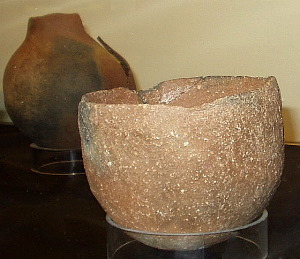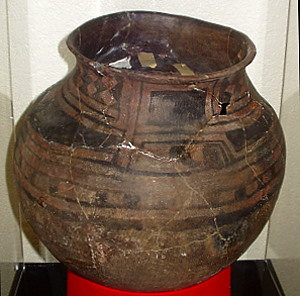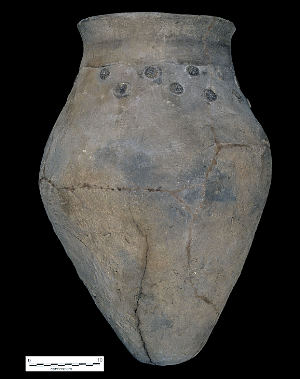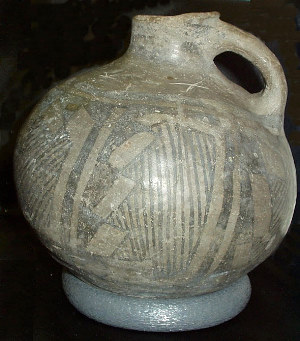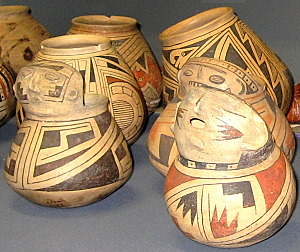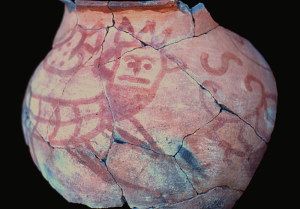Pottery of the Trans-Pecos
The native ceramics from the western Trans-Pecos are collectively referred to as El Paso Brownware, and are one of several distinctive ceramic traditions of the American Southwest and northern Mexico. El Paso Brownware was produced by peoples who belonged to the Jornada Mogollon culture —the easternmost branch of the Mogollon culture (one of the "big three" cultures of the Southwest). The Jornada Mogollon region encompasses the western Trans-Pecos, south-central New Mexico, and northeastern Chihuahua.
The first Jornada Mogollon ceramics, known as El Paso Brown, were produced sometime between A.D. 200 and 400. They are stylistically and technologically simple and changed very little until about A.D. 800, when ceramics began to play an expanded role in food preparation technology, particularly in large-scale food processing. At this time, Jornada Mogollon peoples began to produce El Paso Bichrome, which was quickly followed by Early El Paso Polychrome. Though they retain the same vessel forms as El Paso Brown, these types of ceramics are decorated with simple geometric designs. It is not known whether these three types were briefly produced at the same time, or if they replaced one another in rapid succession.
Around A.D. 1200 or 1250, Jornada Mogollon peoples began to produce Classic El Paso Polychrome. This type differs from the previous types of El Paso Brownware in its more elaborate designs and new vessel forms. Unlike most ceramic types, Classic El Paso Polychrome was never produced in conjunction with a plain, utilitarian type. Instead, the lower portion of its vessels (the part that comes into contact with heating fires) is undecorated, in essence allowing it to serve both as a decorated and utilitarian ware.
In addition to producing their own ceramics, Jornada Mogollon peoples acquired ceramics from their neighbors. The most common intrusive ceramic types found in the region are Mimbres Black-on-white from southern New Mexico, Chupadero Black-on-white from east-central New Mexico, and various ceramic types from the Casas Grandes region of northern Chihuahua, Mexico. Though Jornada Mogollon peoples primarily acquired ceramics from nearby areas of New Mexico and Chihuahua, ceramics from as far away as northern New Mexico and parts of Arizona have also been found in the region.
The El Paso Brownware ceramic tradition came to an end when the pueblos of the Jornada Mogollon region were abandoned around A.D. 1450. For the next 230 years, little is known about any ceramics that may have been produced in the Trans-Pecos. The exception to this is the La Junta district, where ceramics began to be produced for the first time around A.D. 1450. Seven types of La Junta ceramics have been named, but none have been formally defined and studied in detail. Some are undecorated utilitarian wares, some are unpainted textured wares, and some are decorated red-on-brown wares. The La Junta ceramic tradition came to an end in the mid to late 18th century.
At the beginning of the Spanish Colonial/Post-Pueblo Revolt period in A.D. 1680, the Historic El Paso Brownware ceramic tradition was established by the Indians living in the missions of El Paso. This tradition consisted initially of undecorated utilitarian brownwares, such as Ysleta Brown, Socorro Brown, and Socorro Smudged, but these types were soon followed by decorated red-on-brown wares, such as Socorro Red-on-brown, which features designs that blend Native and European styles. The Mission Indians also participated in regional exchange networks, particularly along the Camino Real, and acquired indigenous ceramics from the pueblos of northern and central New Mexico as well as factory-made ceramics from Mexico.
Contributed by Carly Whelan.
Brown, David O., John A. Peterson and David V. Hill
1999 Discourse in Clay: Ceramics and Culture in Historic Socorro, Texas. Bulletin of the Texas Archeological Society 70:421-438.
Brown, Roy B., Patricia Fournier, David V. Hill, John A. Peterson and Mark Willis
2004 Settlement and Ceramics in Northern New Spain: A Case Study of Brown Ware Pottery and Historical Change. In: Surveying the Archaeology of Northwest Mexico, edited by Gillian E. Newell and Emiliano Gallaga, pp. 265-288. The University of Utah Press, Salt Lake City.
Cloud, William A.
2004 The Arroyo de la Presa Site: A Stratified Late Prehistoric Campsite along the Rio Grande, Presidio County, Trans-Pecos, Texas. Report prepared by the Center for Big Bend Studies, Sul Ross State University, Alpine, Texas, for the Texas Department of Transportation, Austin.
Larkin, Karin B., Jane H. Kelley and Mitchel J. Hendrickson
2004 Ceramics as Temporal and Spatial Indicators in Chihuahua Cultures. In: Surveying the Archaeology of Northwest Mexico, edited by Gillian E. Newell and Emiliano Gallaga, pp. 177-204. The University of Utah Press, Salt Lake City.
Miller, Myles R.
1996 The Chronometric and Relative Chronology Project. Archaeological Technical Report No. 5. Anthropology Research Center and Department of Sociology and Anthropology, University of Texas at El Paso, El Paso.
Perttula, Timothy K., Myles R. Miller, Robert A. Ricklis, Daniel J. Prikryl, and C. Lintz
1995 Prehistoric and Historic Aboriginal Ceramics in Texas. Bulletin of the Texas Archeological Society 66:175-235.
Whalen, Michael E.
1994 Turquoise Ridge and Late Prehistoric Residential Mobility in the Desert Mogollon Region. Anthropological Papers No. 118. The University of Utah Press, Salt Lake City.
